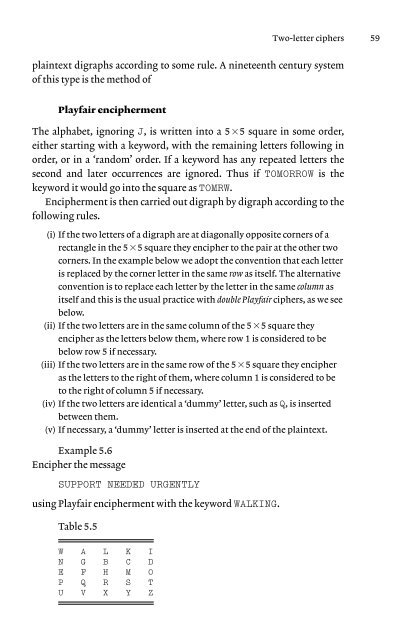Code and ciphers: Julius Caesar, the Enigma and the internet
Code and ciphers: Julius Caesar, the Enigma and the internet
Code and ciphers: Julius Caesar, the Enigma and the internet
You also want an ePaper? Increase the reach of your titles
YUMPU automatically turns print PDFs into web optimized ePapers that Google loves.
plaintext digraphs according to some rule. A nineteenth century system<br />
of this type is <strong>the</strong> method of<br />
Playfair encipherment<br />
The alphabet, ignoring J, is written into a 5�5 square in some order,<br />
ei<strong>the</strong>r starting with a keyword, with <strong>the</strong> remaining letters following in<br />
order, or in a ‘r<strong>and</strong>om’ order. If a keyword has any repeated letters <strong>the</strong><br />
second <strong>and</strong> later occurrences are ignored. Thus if TOMORROW is <strong>the</strong><br />
keyword it would go into <strong>the</strong> square as TOMRW.<br />
Encipherment is <strong>the</strong>n carried out digraph by digraph according to <strong>the</strong><br />
following rules.<br />
(i) If <strong>the</strong> two letters of a digraph are at diagonally opposite corners of a<br />
rectangle in <strong>the</strong> 5�5 square <strong>the</strong>y encipher to <strong>the</strong> pair at <strong>the</strong> o<strong>the</strong>r two<br />
corners. In <strong>the</strong> example below we adopt <strong>the</strong> convention that each letter<br />
is replaced by <strong>the</strong> corner letter in <strong>the</strong> same row as itself. The alternative<br />
convention is to replace each letter by <strong>the</strong> letter in <strong>the</strong> same column as<br />
itself <strong>and</strong> this is <strong>the</strong> usual practice with double Playfair <strong>ciphers</strong>, as we see<br />
below.<br />
(ii) If <strong>the</strong> two letters are in <strong>the</strong> same column of <strong>the</strong> 5�5 square <strong>the</strong>y<br />
encipher as <strong>the</strong> letters below <strong>the</strong>m, where row 1 is considered to be<br />
below row 5 if necessary.<br />
(iii) If <strong>the</strong> two letters are in <strong>the</strong> same row of <strong>the</strong> 5�5 square <strong>the</strong>y encipher<br />
as <strong>the</strong> letters to <strong>the</strong> right of <strong>the</strong>m, where column 1 is considered to be<br />
to <strong>the</strong> right of column 5 if necessary.<br />
(iv) If <strong>the</strong> two letters are identical a ‘dummy’ letter, such as Q, is inserted<br />
between <strong>the</strong>m.<br />
(v) If necessary, a ‘dummy’ letter is inserted at <strong>the</strong> end of <strong>the</strong> plaintext.<br />
Example 5.6<br />
Encipher <strong>the</strong> message<br />
SUPPORT NEEDED URGENTLY<br />
using Playfair encipherment with <strong>the</strong> keyword WALKING.<br />
Table 5.5<br />
W A L K I<br />
N G B C D<br />
E F H M O<br />
P Q R S T<br />
U V X Y Z<br />
Two-letter <strong>ciphers</strong> 59

















